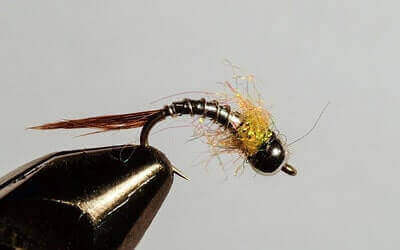Disclosure: We may earn commissions if you purchase products after clicking on a link from our site.
Do you want to learn how to fly fishing with nymphs? Do you know that nymphing is one of the challenging ways of fishing? If you learn fly fishing with nymphs you will be surprised at how many fishes you will catch. In this article, we discuss how to fly fish with nymphs and other things related to nymph fishing.
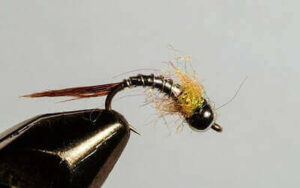
Table of Contents
Fly Fishing With Nymphs Tips
1. Always take a variety of nymphs, including types and sizes. Study the water to determine which sizes and types might work. However, you have to try different types and sizes to find the right one. Make sure your selection of nymphs has a lot of patterns in sizes 16 and smaller.
2. Look out for fast-moving, pocket water that will be difficult to reach. This area of water will be difficult to get nymphing rigs into, but it also means there will be less fishing pressure there and as a result, more trout. Cast along the edges of the rocks so the nymph drifts through the pocket and down the seam.
Make sure your fly rod is high as your nymph drifts through the pocket water. If you can persist and get your nymphing rigs in that area, you might be rewarded with many catches.
3. One of the first things you need to do is study the water to determine what kind of natural nymphs the trout are preying on. With this information, you can find an artificial fly that closely resembles the natural nymph. Math the color, size, and design as much as possible.
4. When fly fishing with nymphs, your presentation has to be very good to get the trout to go for your nymph. Therefore, you will need to study the water well so that your presentation of the nymph will get the trout to bite. You will be more successful in catching trout if your nymphs look more real.
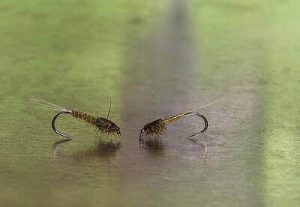
5. The depth of the water is very important when fly fishing with nymphs. Nymphs usually are located at the bottom and this is where trout are found to get the nymphs. You have to understand the water depth, speed, and how long it will take for your setup to reach the bottom. If your nymph doesn’t touch the bottom, it simply means that you are not deep enough.
6. Line control is very important when fly fishing with nymphs. Use properly sized strike indicators and try to fish within 30 feet. Work close into a seam in the current and cast upstream at a 25 to 40-degree angle. It is also good to strip the line as it drifts with the current until you achieve a good drift. You can also lift the rod tip sharply to set the hook.
7. When casting, keep the line short, control the rod tip, and extend the rod tip forward a bit more than usual.
8. When the trout are not biting on your nymphs, you can downsize. You can go for a size 16 or 18 instead of a 10 or 12. Chances are you might start seeing more success. Trouts don’t like to expend a lot of energy, therefore, smaller nymphs that are close to them might trigger a bite from the trout.
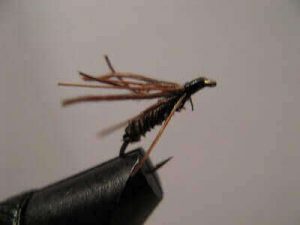
9. If you find yourself nymph fishing in the same spot for more than thirty minutes without getting a bite, then it is time to move on to another spot. Successful nymph anglers know when to give up a spot and move to another one.
10. Always shorten the number of lines you have on the water. This will help you in identifying strikes and getting more fish. When you detect a strike, you want to set the hook before the fish gets away. Using a short line will only help you achieve that. Every additional line is more lag time between seeing and feeling a strike and setting the hook before the fish frees itself and leaves.
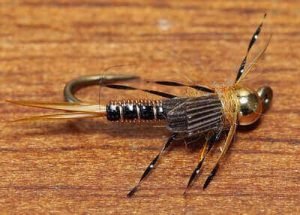
Fly Fishing Techniques
There are a number of fly fishing techniques you can use to put your flies in the direction of fish. By learning them, you will be more successful as a nymph angler.
1. The Wet Fly Swing
The Wet fly swing is a fly fishing technique in which you cast a fly across the current and let it “swing” below you and down to the trout. Cast upstream around 45 degrees followed by quick mend. The wet fly swing works well in slow to medium-paced currents than in fast waters. It can be used to locate the fish in slow-moving pools.
2. Direct Upstream Casting
The direct upstream technique is implemented by casting straight upstream or slightly across and upstream. The rod tip should be kept low and stripped in line as the current brings it to you. The line will seem to jump upstream when you get a bite or the leader will tighten. Set the hook if the line does anything other than the usual while coming back downstream and drifting with the current.
With this technique, you are casting over the heads of fish which could spook them. Hence, the direct upstream casting technique is best for faster water in which the splash of the line and the fly will both be covered by the noise of the water.
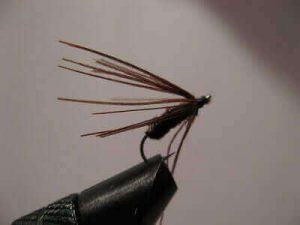
3. High Sticking
High sticking is a technique to keep most of the fly line off of the water by holding the tip of the rod as high as it can be. This method will work with shorter upstream casts and is ideal for fast, swirling water.
4. Two Fly Rigs
Using two nymphs at one time is another nymphing technique called two fly rigs. This technique allows you to use two different fly patterns to locate the fish. It should not be used in an area with a lot of brush or where snags are regular as you can snag easily and then lose two flies instead of just one. It should also be avoided in windy situations because there will be more tangles.
5. Light Rig
Light rig is another fly fishing technique that doesn’t use the fly line. With this technique, the fish will not get spooked and there will be less time tangled in trees and bushes.
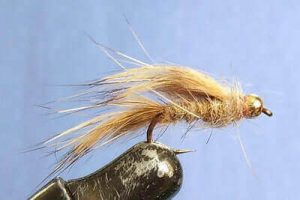
Main Types of Nymphs
1. Mayfly
Mayflies, known for their ephemeral adult stage, begin their life cycle as aquatic nymphs. These nymphs inhabit freshwater bodies such as rivers, streams, and lakes, where they play a crucial role in freshwater ecosystems as both predators and prey.
Mayfly nymphs typically have elongated bodies with flattened abdomens and three distinct tail filaments, known as cerci. They possess well-developed legs for swimming and crawling along the substrate, where they feed on algae, detritus, and other organic matter.
As they mature, mayfly nymphs undergo several molts, shedding their exoskeletons to accommodate growth. This aquatic nymphal stage can last from several months to several years, depending on the species and environmental conditions. Eventually, when conditions are favorable, mayfly nymphs emerge from the water as winged adults to complete their life cycle, contributing to the rich biodiversity of freshwater ecosystems.
2. Caddis
Caddisflies, renowned for their diverse and adaptive nymphal stages, are vital components of freshwater ecosystems. Caddis nymphs, often referred to as “larvae,” inhabit streams, rivers, lakes, and ponds worldwide, where they play critical roles as both herbivores and detritivores.
These aquatic larvae construct protective cases using silk and natural materials such as sand, gravel, twigs, or plant fragments, which they carry with them as they move and feed. Caddisfly larvae exhibit various feeding strategies, with some species grazing on algae and aquatic vegetation, while others scavenge organic debris or capture small invertebrates.
Their robust silk-producing glands enable them to construct intricate and durable structures that provide camouflage and protection from predators. As caddis larvae mature, they undergo several molts, gradually developing wing pads and other adult features. Eventually, they undergo metamorphosis, emerging from the water as winged adults to complete their life cycle, contributing to the rich biodiversity of freshwater ecosystems
3. Stonefly
Stoneflies, members of the order Plecoptera, are aquatic insects found in freshwater habitats worldwide, from fast-flowing streams to calm rivers and lakes. The nymph stage of the stonefly life cycle is highly adapted for life underwater, characterized by a robust body, large thorax, and well-developed legs equipped for navigating strong currents.
Stonefly nymphs are typically sensitive to water quality and are often considered indicators of clean, well-oxygenated aquatic environments. They are voracious predators, feeding on algae, small invertebrates, and detritus, playing a crucial role in regulating populations of other aquatic organisms. Stonefly nymphs exhibit various adaptations for survival, including camouflage and burrowing behavior to avoid predators and access food sources.
As nymphs mature, they undergo incomplete metamorphosis, with several molts before emerging as winged adults. Stonefly nymphs are essential components of freshwater ecosystems, contributing to nutrient cycling and serving as a vital food source for fish and other aquatic predators.

Stages of Nymph Development
1. Larval or Nymph Stage
In the context of insect development, the term “larva” refers to the immature stage of an insect’s life cycle that undergoes complete metamorphosis, transitioning into an adult form. Larvae are typically distinct from adults in appearance and behavior, often specialized for feeding and growth. In the nymph development of aquatic insects like mayflies, stoneflies, and caddisflies, the larval stage represents the early phase of life spent predominantly in water.
During this stage, larvae exhibit adaptations suited for their aquatic environment, such as streamlined bodies, gills for breathing underwater, and specialized appendages for swimming or crawling. Larvae primarily feed on algae, organic matter, or other small aquatic organisms, fueling their growth and development. As they mature, larvae undergo successive molts, shedding their exoskeleton to accommodate growth until they reach the final larval instar.
Eventually, larvae undergo metamorphosis, transitioning into pupae before emerging as winged adults. The larval stage is critical for the growth and survival of nymphs, playing a vital role in freshwater ecosystems as primary consumers and contributors to nutrient cycling.
2. Pupae or Emerger Nymph Stage
During the nymph development of aquatic insects such as mayflies, stoneflies, and caddisflies, the pupae or emerger stage represents a transitional phase between the larval and adult forms. After completing their growth as larvae, nymphs undergo metamorphosis, transforming into pupae or emergers.
This transformation typically occurs underwater, where the nymphs find sheltered areas to molt and undergo physical changes. Pupae or emergers often exhibit distinctive features such as wing pads and streamlined bodies, preparing them for their emergence from the water’s surface.
During this stage, pupae are relatively inactive, conserving energy as they undergo internal changes necessary for the transition to adulthood. Once fully developed, pupae ascend to the water’s surface, where they emerge into the air or crawl onto nearby vegetation. The emergence process is a critical and vulnerable period for nymphs, as they are exposed to predation and environmental factors.
However, successful emergence marks the beginning of their adult life stage, where they acquire wings and reproductive capabilities. The pupal or emerger stage is integral to the life cycle of aquatic insects, facilitating their transition from aquatic to terrestrial habitats and contributing to the ecological dynamics of freshwater ecosystems.
3. Adult Stage
The adult stage represents the final phase in the development of nymphs, marking their transition from aquatic to terrestrial life. After emerging from the water’s surface as pupae or emergers, nymphs undergo a series of physiological changes to transform into fully developed adults.
During this transition, nymphs shed their aquatic features, such as gills and streamlined bodies, and develop adaptations suited for life on land. One of the most notable changes is the development of wings, which enable adults to fly and disperse to new habitats.
Additionally, adults acquire reproductive organs necessary for mating and laying eggs, ensuring the continuation of their species. Once fully matured, adults actively engage in behaviors such as feeding, mating, and oviposition, contributing to the ecological dynamics of their respective habitats. The adult stage represents the culmination of the nymph’s development and is crucial for maintaining population levels and sustaining freshwater ecosystems.
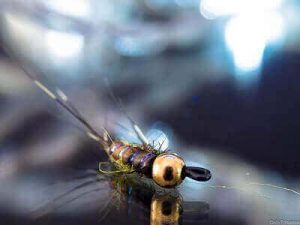
Best Flies for Nymph Fishing
1. Cannon’s or San Juan Worm
Cannon’s or San Juan Worm is a highly effective fly used in nymph fishing, particularly in freshwater trout streams and rivers. This artificial fly imitates the appearance of aquatic worms or annelids, which are a staple food source for many fish species, including trout.
Typically tied using brightly colored chenille or yarn materials, such as red or pink, Cannon’s or San Juan Worm is designed to mimic the natural coloration and movement of real worms found in aquatic environments.
Anglers often employ this fly in fast-moving water or during periods of increased flow, as the worm-like appearance and subtle movements can trigger strikes from hungry fish. Whether dead-drifted along the river bottom or swung through riffles and runs, Cannon’s or San Juan Worm has proven to be a reliable pattern for enticing trout and other freshwater species to bite, making it a popular choice among fly anglers worldwide.
2. Hare’s Ear Nymph
The Hare’s Ear Nymph is a classic and versatile fly pattern widely used in nymph fishing across various freshwater habitats. Mimicking the appearance of aquatic insects in their nymphal stage, this fly features a natural, buggy profile that effectively entices trout and other species.
Tied with a mix of natural materials such as hare’s fur or dubbing, along with synthetic fibers for added durability, the Hare’s Ear Nymph offers a lifelike imitation of mayfly nymphs, caddis larvae, and stonefly nymphs, among other aquatic insects. Its versatility lies in its ability to imitate a wide range of insect species, making it a go-to pattern for fly anglers in both rivers and streams.
Whether dead-drifted near the river bottom or swung through riffles and pockets, the Hare’s Ear Nymph’s subtle natural hues and suggestive silhouette make it a reliable choice for enticing wary trout in various fishing conditions.
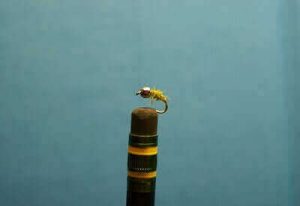
3. Zebra Midge
The Zebra Midge is a highly effective and popular fly pattern for nymph fishing, particularly in streams and rivers where midges are abundant. Characterized by its simplicity and effectiveness, the Zebra Midge typically consists of a slim, cylindrical body made from fine thread or tinsel, often adorned with a single strand of wire ribbing.
Available in a variety of colors such as black, red, olive, and brown, the Zebra Midge can imitate various stages of midge larvae, pupae, and emergers. Despite its minimalist appearance, this fly has a remarkable ability to attract trout and other fish species, especially during periods when midges are active.
Anglers often fish the Zebra Midge in tandem with other nymph patterns or as part of a multi-fly setup, presenting it at various depths in the water column using techniques like drift fishing or tight-line nymphing. Its versatility, simplicity, and effectiveness make the Zebra Midge a staple in the fly boxes of anglers seeking success in waters where midges play a significant role in the trout’s diet.
4. Prince Nymph
The Prince Nymph is a classic and versatile fly pattern that has been a staple in fly anglers’ boxes for decades. This effective nymph pattern is known for its ability to imitate a wide range of aquatic insects, making it a go-to choice in various fishing conditions. Typically tied with a bead head to help it sink quickly, the Prince Nymph features a distinctive profile with a peacock herl body, brown or black hackle fibers for legs, and a white goose biot tail.
Additionally, it often includes strands of pearl or copper wire for ribbing and a wing case made of pheasant tail fibers or synthetic materials. The combination of these elements creates a lifelike appearance in the water, making it irresistible to trout and other freshwater species.
Anglers commonly fish the Prince Nymph in both still waters and rivers, presenting it using techniques such as dead drifting, nymphing under indicators, or high-stick nymphing. Its versatility, effectiveness, and ability to mimic various aquatic insects make the Prince Nymph a must-have pattern in any nymph angler’s arsenal.
5. Copper John
The Copper John is a highly effective and popular fly pattern used by fly anglers worldwide for nymph fishing. Designed by legendary fly tyer John Barr, this versatile pattern imitates a variety of aquatic insects, particularly mayfly nymphs and stonefly nymphs, making it a go-to choice in many fishing situations.
The Copper John typically features a heavy brass or copper bead head, which helps it sink quickly to the desired depth, and a body made of copper wire wrapped around a hook shank.
Additionally, it often includes a tail made of pheasant tail fibers, a thorax made of peacock herl or dubbing, and wings made of synthetic materials or turkey biots. The combination of these elements creates a lifelike appearance in the water, attracting the attention of trout and other freshwater species.
Anglers commonly fish the Copper John using nymphing techniques such as dead drifting, tight lining, or indicator nymphing, both in rivers and still waters. Its effectiveness, versatility, and ability to sink quickly to the feeding zone make the Copper John a staple in any nymph angler’s fly box.
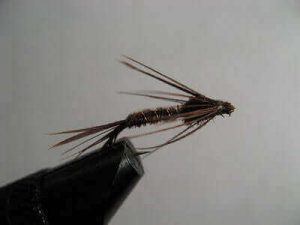
6. Bead Head Soft-Hackle Pheasant Tail
The Bead Head Soft-Hackle Pheasant Tail is a classic and versatile fly pattern that has remained a favorite among fly anglers for decades, particularly for nymph fishing. It is a variation of the traditional Pheasant Tail nymph, featuring a bead head that adds weight and helps the fly sink quickly to the desired depth in the water column.
The soft-hackle collar provides natural movement and lifelike action to the fly, mimicking the movement of emerging insects or struggling nymphs. This pattern typically incorporates a body made of pheasant tail fibers, which imitate the slender bodies of mayfly nymphs, and a thorax made of peacock herl or synthetic dubbing for added attraction.
The combination of these materials creates a highly effective imitation of aquatic insects, making it irresistible to trout and other freshwater species. Anglers often fish the Bead Head Soft-Hackle Pheasant Tail using traditional nymphing techniques such as dead drifting, swinging, or stripping, both in rivers and still waters. Its simplicity, effectiveness, and versatility make it a must-have pattern in any nymph angler’s fly box.
7. Rubber Legs
Rubber Legs is a highly effective fly pattern for nymph fishing, renowned for its ability to attract trout and other freshwater species. This fly features long, thin rubber legs that provide lifelike movement and mimic the appearance of insect appendages, particularly stonefly or cranefly legs.
The exaggerated movement of the rubber legs in the water can trigger aggressive strikes from fish, especially in fast-flowing or turbulent currents where larger nymphs are prevalent. The body of the Rubber Legs fly is typically made of dubbing, chenille, or other synthetic materials to imitate the natural colors and segmentation of aquatic insects.
Some variations may incorporate a bead head or weighted wire to help the fly sink quickly to the desired depth. Anglers often fish Rubber Legs nymphs using various nymphing techniques such as dead drifting, bouncing along the bottom, or swinging through the current. Whether used as a standalone pattern or in tandem with other nymphs, Rubber Legs flies are a staple in any nymph angler’s arsenal due to their effectiveness and versatility in a wide range of fishing conditions and environments.
8. Sow Bug
The Sow Bug, a popular choice among fly fishermen for nymph fishing, is a highly effective pattern designed to imitate small aquatic crustaceans found in freshwater streams and rivers. These bugs are a significant food source for trout and other fish species, making the Sow Bug fly an indispensable part of any angler’s arsenal.
Typically tied with a slender, segmented body and often featuring a soft, undulating appearance, the Sow Bug fly mimics the natural movement and silhouette of its real-life counterpart. The fly’s success lies in its ability to closely resemble the behavior and appearance of the natural insect, enticing strikes from hungry fish seeking an easy meal.
Anglers often present the Sow Bug fly using various nymphing techniques such as dead drifting along the bottom, bouncing through riffles, or swinging in the current. Its versatility and effectiveness in imitating a prevalent food source make the Sow Bug fly a go-to pattern for nymph fishermen targeting trout and other freshwater species in streams and rivers worldwide.
9. Rainbow Warrior
The Rainbow Warrior is a dynamic and visually striking fly pattern renowned for its effectiveness in nymph fishing, particularly in rivers and streams where trout thrive. Crafted to mimic aquatic insects and small baitfish, this fly features vibrant colors and flashy materials that catch the attention of hungry fish.
The Rainbow Warrior typically incorporates a slender, tapered body adorned with metallic or holographic materials, often paired with a shimmering wing case and a distinctive hot spot near the thorax. Its eye-catching appearance and lifelike movement in the water make it irresistible to trout and other freshwater species.
Anglers frequently employ the Rainbow Warrior in various nymphing techniques, such as drift fishing along the bottom or swinging through riffles and runs, to entice strikes from opportunistic fish. Whether used as part of a tandem nymph rig or fished solo, the Rainbow Warrior consistently proves its worth as a reliable and productive fly pattern for anglers seeking success on the water.
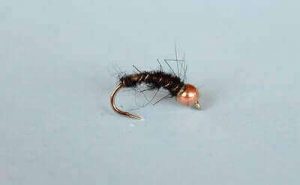
10. Iron Lotus
The Iron Lotus is a versatile and innovative fly pattern that has gained popularity among fly anglers for its effectiveness in nymph fishing, particularly in trout streams and rivers. This fly is designed to mimic various aquatic insects, such as mayflies, caddisflies, and stoneflies, making it a reliable choice in a range of aquatic environments.
The Iron Lotus typically features a slender and tapered body with intricate detailing to imitate the natural profile of nymphs underwater. Its unique construction often incorporates a combination of synthetic and natural materials, including feathers, fur, and flash, to create a realistic appearance and enticing movement in the water. The fly’s name, Iron Lotus, reflects its durability and resilience, traits that are essential for withstanding the rigors of nymphing in fast-flowing currents and rocky substrates.
Anglers commonly present the Iron Lotus using various nymphing techniques, such as dead drifting along the bottom or actively twitching to simulate natural insect behavior, to entice strikes from discerning trout. With its proven effectiveness and versatility, the Iron Lotus has become a staple in the fly boxes of anglers seeking success in nymph fishing scenarios.
The Bottom Line
Fly fishing with nymphs is not one of the easiest ways to catch fish. However, you can learn and get good at it. It is an effective way to catch trout as they have a voracious appetite. In this article, we discussed how to fly fish with nymphs.
We hope that this article gave you some ideas to become a better angler using nymphs. This article on fly fishing tips helps you be more successful with fly fishing. If you need sling packs, you can read the best fly fishing sling packs.
